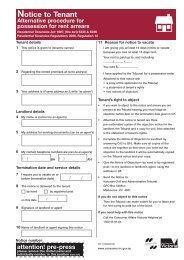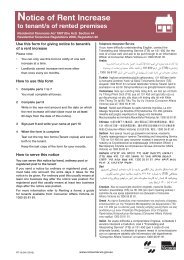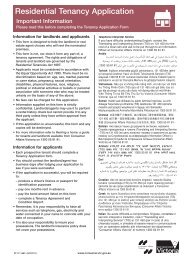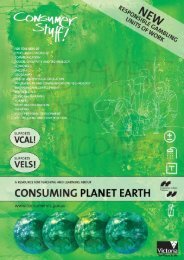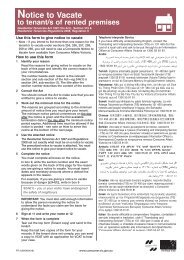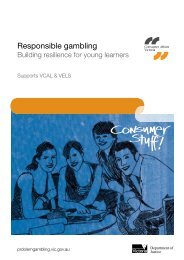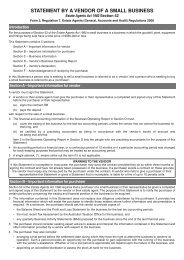Consumer Stuff for kids (PDF, 6.2 MB) - Consumer Affairs Victoria
Consumer Stuff for kids (PDF, 6.2 MB) - Consumer Affairs Victoria
Consumer Stuff for kids (PDF, 6.2 MB) - Consumer Affairs Victoria
Create successful ePaper yourself
Turn your PDF publications into a flip-book with our unique Google optimized e-Paper software.
ACTIVITY 3 - Using Resources<br />
Learning Objectives<br />
• Students expand their economic vocabulary to include the terms<br />
demand, production and distribution.<br />
• Students understand the interrelationship between producers and<br />
consumers and how they determine which goods and services are<br />
produced.<br />
Lesson Duration<br />
» 60 minutes<br />
Teacher Notes<br />
Encourage students to identify real-life examples which show how consumer demand links to<br />
supply. For example, if consumers enjoy a particular movie, consumer demand often results<br />
in movie sequels being produced. The opposite is also true. If a particular television show no<br />
longer interests consumers the show will soon be replaced by something else.<br />
Introduction<br />
Using one of Tony Ryan’s Thinkers Keys activities, apply “The Commonality” technique.<br />
Ask students:<br />
“Explain a connection between two words. The connection must have something to do with production”.<br />
For example: <strong>for</strong>est and furniture – Trees in <strong>for</strong>ests are used <strong>for</strong> timber to produce furniture.<br />
Possible connections are included.<br />
• sheep-dog and carpet - [A sheep-dog works on a farm with sheep. The wool from sheep is<br />
used to produce carpet]<br />
• leather handbag and fresh grass - [Leather bags are often produced using hide leather from<br />
animals which eat fresh grass]<br />
• electricity and a large hole in the ground - [Much of Australia’s electricity is produced by<br />
extracting coal from the ground]<br />
• pizza and wheat farmer - [Dough is a main ingredient of pizza. Dough is produced from<br />
wheat which is harvested by a wheat farmer]<br />
• vegetables at a market and diesel fuel - [Fresh vegetables are usually picked and transported<br />
to shops and supermarkets by trucks fuelled by diesel]<br />
• a miner and a $1 coin - [Australia’s $1 coin is made by natural resources including copper,<br />
aluminium and nickel which are mined]<br />
Distribute the A3 activity sheet Sam’s Soccer Ball Factory to students in groups of 2 or 3.<br />
Key Terms<br />
• demand<br />
• production<br />
• producers<br />
• distribution<br />
• export<br />
Preparation<br />
» copy A3 activity Sam’s Soccer Ball Factory, one per 2 – 3 students optional<br />
assessment activity:<br />
» copy Making Coloured Pencils<br />
Task - Sam's Soccer Ball Factory<br />
CONSUMER AFFAIRS VICTORIA NEED CONSUMER HELP? 1300 55 81 81 www.consumer.vic.gov.au<br />
61



